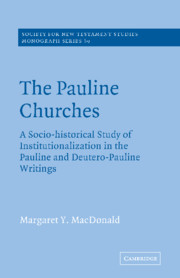 The Pauline Churches
The Pauline Churches Published online by Cambridge University Press: 10 December 2009
Colossians and Ephesians reflect the continued existence of Pauline churches in the absence of the Apostle. The following study explores the nature of the community life underlying these writings. It does not constitute a defence of the pseudonymity of Colossians and Ephesians. Rather, it considers the implications of pseudonymity for understanding the social mechanisms at work in the early church. The investigation traces the development of a Pauline movement that stretched beyond the boundaries of the Apostle's own lifetime.
Throughout this section, comparisons will be made between the authentic epistles, and Colossians and Ephesians. The relationship between the writings will be analysed in terms of the ongoing process of institutionalization. When differences appear, suggestions will be made as to the historical factors acting as catalysts for change. Similarities will be discussed with a view to comprehending the continued relevance of certain aspects of the Pauline symbol system for communities faced with new social situations.
The means employed by the communities of Colossians and Ephesians to deal with the absence or death of Paul will be of primary significance for this study. As the Pauline movement incorporated new generations, it was faced with different problems from those of the early days of community formation. However, the existence of Pauline traditions provided some guidelines to cope with new situations.
To save this book to your Kindle, first ensure [email protected] is added to your Approved Personal Document E-mail List under your Personal Document Settings on the Manage Your Content and Devices page of your Amazon account. Then enter the ‘name’ part of your Kindle email address below. Find out more about saving to your Kindle.
Note you can select to save to either the @free.kindle.com or @kindle.com variations. ‘@free.kindle.com’ emails are free but can only be saved to your device when it is connected to wi-fi. ‘@kindle.com’ emails can be delivered even when you are not connected to wi-fi, but note that service fees apply.
Find out more about the Kindle Personal Document Service.
To save content items to your account, please confirm that you agree to abide by our usage policies. If this is the first time you use this feature, you will be asked to authorise Cambridge Core to connect with your account. Find out more about saving content to Dropbox.
To save content items to your account, please confirm that you agree to abide by our usage policies. If this is the first time you use this feature, you will be asked to authorise Cambridge Core to connect with your account. Find out more about saving content to Google Drive.